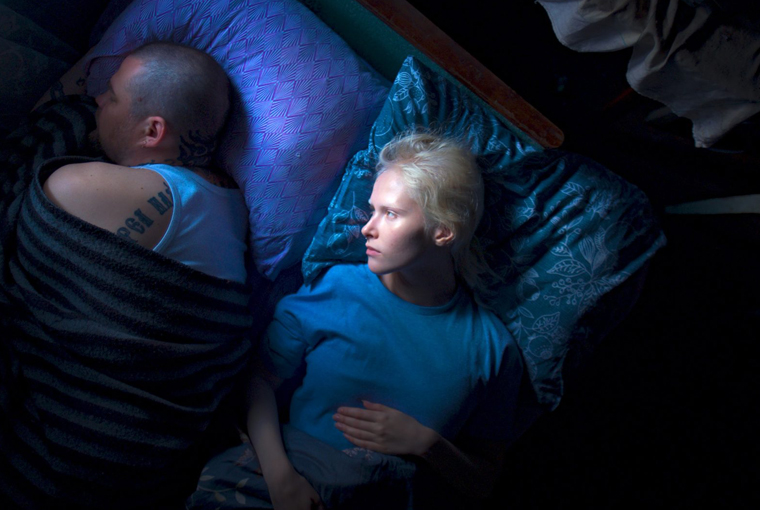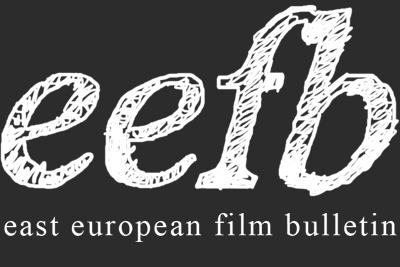Beauty and the Beast
Elsa Kremser and Levin Peter’s White Snail (2025)
Vol. 154 (April 2025) by Isabel Jacobs
Just after its world premiere in Locarno, where it won the Special Jury Prize and the Pardo for Best Performance, Elsa Kremser and Levin Peter’s White Snail (2025) screens in the Sarajevo Film Festival’s main competition. At once magical fairytale and rare glimpse into contemporary Belarus, it marks the directing duo’s first venture into fiction. Drawing from the lives of its non-professional cast, White Snail is a tender love story set in Minsk about two outsiders searching for their place in the world.
At the center are Masha (Marya Imbro), a young model with dreams of working in China, and Misha (Mikhail Senkov), a painter who works the night shift in a morgue. Both are outcasts: she, an ice queen too otherworldly for her model school; he, covered in tattoos (including a Dante quote), living in a cramped flat with his mother and turtle. He paints by day and tends to the dead by night, while she models by day and wanders the city after dark, eventually being drawn into his world. When their paths cross, their lives are turned upside down. As the directors put it: “Open questions about a future not yet decipherable arise, like something smoldering in the haze of sultry summer nights.”1
A German-Austrian co-production, the film was shot in Belarus and Latvia under the shadow of the war in Ukraine. While news blares in the background and flashes across smartphone screens, the protagonists turn toward mythology and ritual. Provincial boredom is infused with magical elements. In one of the most striking scenes, Misha leads Masha to an enchanted tree in the forest, urging her to crawl through its hollow trunk as a rite of transformation. When she refuses, he undresses and disappears into the tree himself. Another scene recalls folk mythology: they sit by a lake said to have swallowed an entire village of outcasts who walked into the water one by one to escape persecution, until Masha cheekily interjects: “Why didn’t they just go to Poland?”
Kremser and Peter portray a Belarus caught between political crisis and spiritual revival. In a scene both hilarious and disturbing, Masha is taken to a local exorcist, an entirely documentary episode. “We didn’t move a single stone,” Kremser explains, “because it was important for the exorcist to keep the energy flowing. She truly believed in the demons and the need to expel them from Masha.” In Belarus, esoteric traditions run deep.
In its bold yet unpretentious style, White Snail celebrates the fragile beauty of this liminal space and its defiant resistance to social norms. The film’s painterly texture increases this contrast, juxtaposing light and dark, harsh reality and dreamy fairytale. The film is visually stunning, with Mikhail Khursevich’s camera tracing a Belarusian landscape that feels both mythical and haunted. The opening shot sets the tone: Masha as an Ophelia-like figure suffocating with a plastic bag wrapped around her head, the scene accompanied by an orchestral score. Later, we find her waking up in a hospital bed.
Senkov’s outsider art is another influence behind White Snail. His paintings have a raw immediacy that is unsettling and pornographic. Bodies appear flayed, dissected, or distorted into grotesque poses, their hollow eye sockets and twisted faces recalling medieval icons. The morgue he inhabits at night seeps into his canvases: wounds, entrails, and genitals in blood red. The body becomes a site of haunting beauty and brutal decay. Like Senkov’s macabre art, White Snail goes under the skin, oscillating between surgical precision and fantasy.
Kremser and Peter first met Senkov ten years ago when attending the Minsk Film Festival: “He invited us to the morgue,” she recalled. “For the first time in my life, I saw a dead body.”2 After encountering his paintings, including one of a girl who survived suicide, the idea of a film began to take shape. “His paintings made me want to see the world through his eyes,” Levin explained during our conversation in Sarajevo.3
While White Snail departed from Senkov’s visceral depictions of pain, Imbro joined the project after the directors found her on social media. In contrast to Senkov’s dark intensity, she embodies a piercing vulnerability, with bleached brows and porcelain skin. They are twins of sorts. Echoing last year’s Toxic, the modelling world appears as a space of both desperate hope and self-destruction.
The film turns bodies inside out. While Masha is judged only for her exterior, she craves recognition for what lies inside; Misha cracks open bodies in the morgue, exposing the unseen. It’s a film about all sorts of liminality: adolescence and adulthood, life and myth, day and night, East and West. It constantly plays with the idea of crossing a threshold: the border between Poland and Belarus or the boundaries of our bodies. Both Masha and Misha exist on the margins. Masha’s frenemies from model school even scrawl the word “witch” in red across her umbrella which protects her white skin from the sun.
The motif of the white snail came straight from Masha’s life: her mother once bought them as a skincare treatment but kept them as pets instead. The snail becomes an important symbol of ambiguity: vulnerable, hermaphroditic, queer, resonating with Masha’s androgynous look, commodified for the Chinese market. Inspired by watching YouTube clips of snails mating, the directors included a memorable close-up of snail sex. As Kremser noted, “they were really crawling into this film.”4
Most of the dialogue is improvised, the script evolving over a decade of conversations between the filmmakers and actors. This gives the film a tender, at times hyperreal quality: every bit feels believable. The performances resist melodrama. At its heart, White Snail is about outsiderdom and the search for a connection. It avoids the pitfalls of folkloric kitsch or magical realism. Instead, its mix of tenderness and authenticity makes it feel remarkably fresh; two hours that drift by like a dream.
- Locarno Film Festival. (n.d.). White Snail. Festival Programme. Retrieved August 21, 2025, from https://www.locarnofestival.ch/festival/program/film.html?fid=57d798f2-208c-4644-a8f6-ffaa98054058&eid=0 ↩︎
- Szalai, G. (2025, August 8). How ‘White Snail’ went from a morgue in Belarus to a world premiere in Locarno. The Hollywood Reporter. https://www.hollywoodreporter.com/movies/movie-news/white-snail-film-belarus-model-morgue-loner-paintings-1236340154/ ↩︎
- Jacobs, I. (2025, April). Elsa Kremser and Levin Peter on White Snail. East European Film Bulletin, (Vol. 154). Retrieved from https://eefb.org/country/belarus/elsa-kremser-and-levin-peter-on-white-snail/ ↩︎
- Szalai, 2025. ↩︎




Leave a Comment